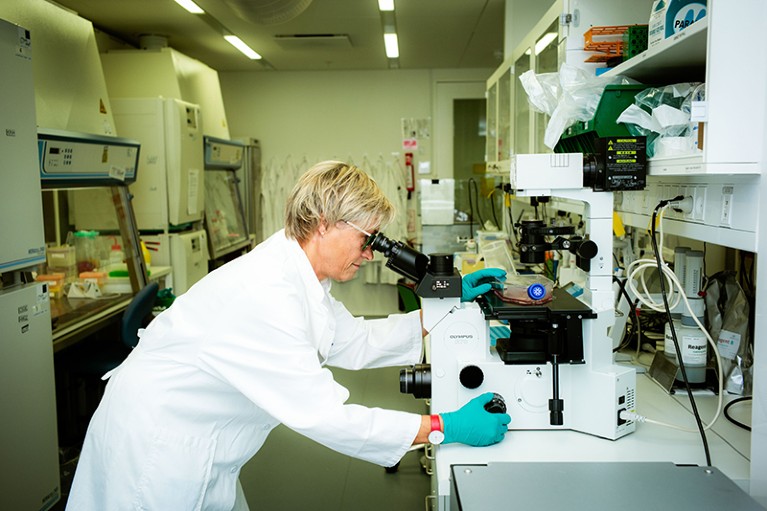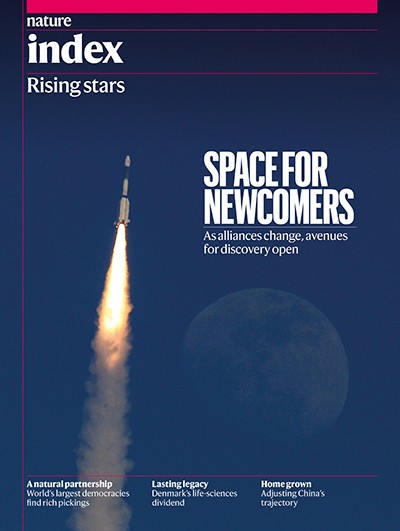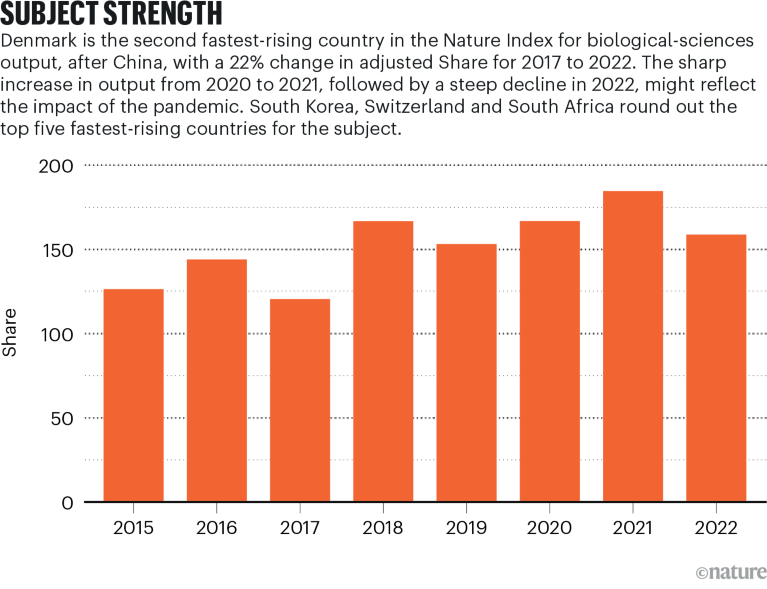
A scientist working at the Novo Nordisk research campus in Måløv, Denmark.Credit: Carsten Snejbjerg/Bloomberg via Getty
The success of Denmark’s life-sciences research sector can be at least partly attributed to a single event that occurred on another side of the world more than a century ago. In 1921, three Canadian scientists, Frederick Banting, Charles Best and John Macleod, extracted and purified the hormone insulin from a dog pancreas. Not long after this, Danish couple Marie and August Krogh — the latter having just won the 1920 Nobel Prize in Physiology or Medicine for his work on the regulation of blood flow — were visiting Canada and learnt of the achievement. They asked permission to introduce the process to Denmark and began manufacturing insulin through the pharmaceutical firm Nordisk Insulinlaboratorium.
Buoyed by the commercial success of insulin as a treatment for diabetes, Nordisk Insulinlaboratorium joined with another company, Novo Terapeutisk Laboratorium, to form Danish pharmaceutical giant Novo Nordisk in 1989. This also marked the launch of the Novo Nordisk Foundation, today one of the wealthiest charitable foundations in the world. The foundation is responsible for investing a significant proportion of Novo Nordisk’s enormous revenue, which is derived from several blockbuster drugs related to diabetes and hormone regulation, into Danish research. In 2022 alone, it awarded close to 7.5 billion Danish krone (US$1 billion) to fund new research initiatives. Many of Denmark’s largest companies are owned by charitable foundations, which are incentivized by tax law to invest in research. “Many of the big foundations have a keen interest in the biomedical research areas or in biotechnology,” says Poul Nissen, a molecular biologist at Aarhus University in Denmark.
Nature Index 2023 Rising stars
The Danish government also invests substantially in research and development through its funding of the academic sector and via the Danish National Research Foundation. This independent research-funding body, established by the Danish parliament in 1991, hands out close to US$70 million each year to fund basic research, more than one-third of which is focused on the life sciences. There is also considerable foreign investment; 28% of people employed in Denmark’s life-sciences sector are in foreign-owned businesses.
For a nation with a population of 5.8 million, this combination of private and public support represents a large amount of research funding. It’s a major factor in the continued success of Denmark’s life-sciences sector, which in the past few years has accelerated its output of high-quality research. In the Nature Index, Denmark was ranked 16th overall for biological sciences-related output in 2022 and it is the second-fastest rising country, after China, in the subject. Denmark’s adjusted Share, which takes account of yearly variations in article volume, increased by 22% from 2017 to 2022, ahead of South Korea (14%) and Switzerland (6%).
According to Bente Stallknecht, dean of the Faculty of Health Sciences at the University of Copenhagen, Denmark’s achievements in insulin production laid the foundations for its strength in many other areas of life-sciences research. “I think it has to do with tradition,” she says. “In Denmark, we’re rather proud of this within life-sciences research and industry.”
One such area is metabolic-hormone research. In 1986, Jens Juul Holst, a diabetes researcher at the University of Copenhagen, discovered GLP-1, an intestinal hormone that stimulates insulin secretion in the pancreas. This led to the development of a new class of drugs known as GLP-1 agonists, produced by Novo Nordisk and other Danish pharmaceutical firms. Denmark’s researchers and pharmaceutical sector continue to build on that legacy with the development of several blockbuster diabetes and obesity drugs, including Ozempic, which offers patients potentially life-saving weight-loss benefits (see S. Sidik Nature 619, 19; 2023).
Denmark is also making its mark in protein chemistry. The Novo Nordisk Foundation Center for Protein Research at the University of Copenhagen, for example, is a world leader in the field of proteomics, the large-scale study of the structure and function of proteins. Since its launch in 2007, the centre has used proteome sequencing to identify more than 14,000 proteins. The characterization and study of these proteins has led to insights, such as the key proteins that are involved in the development of fatty liver disease (L. Niu et al. Mol. Syst. Biol. 15, e8793; 2019). “Handling and using proteins as therapeutics has been a very strong component that links Danish basic research and tradition to our industry today,” says Nissen.
New insights
Denmark’s wealth of research funding is a major advantage for its life-sciences sector. But it also presents an unusual challenge in deciding how, where and on whom to spend it. “As a scientist, we of course prefer that it’s spent on basic research, which we can all apply for,” says Nissen. If the Novo Nordisk Foundation awarded all of its funding to basic research, however, “that would simply overheat our research economy”, he adds.
Recognition that funding needs to be balanced across all stages of the pipeline has partly driven a shift towards projects that aim for real-world impact, says Nissen. Large-scale mission-driven centres, such as the Novo Nordisk Foundation Center for Protein Research, which conducts translational research related to health and disease, have been beneficiaries.

Source: Nature Index
There has also been an emphasis on broadening the pool of researchers within Denmark, into whom this funding can be invested. In 2019, the Danish government prioritized ‘internationalization’ in its efforts to improve its innovation system. In addition to the pool of funding available from its foundations, a focus on internationalization makes Denmark an attractive destination for international students and researchers, says Stallknecht. Higher education in Denmark is free for European Union (EU) students, or those on an exchange programme, and government scholarships are available for students outside the EU.
For researchers, Stallknecht highlights the BRIDGE programme, a two-year postdoctoral fellowship in translational medicine funded by the Novo Nordisk Foundation. Fellows are supervised by researchers from the University of Copenhagen, as well as from industry and hospitals. Since 2014, the University of Copenhagen has doubled its number of international researchers, says Stallknecht. One-third of its institution’s PhD students and 60% of its postdoctoral researchers are international.
In 2021, the Danish government released a new life-sciences strategy, which aims to improve conditions for research and development, including in the use of health data and building a more sustainable health-care system. The strategy follows a surge of interest and investment in building Denmark’s capacity in clinical trials over the past decade, says Jakob Bjerg Larsen, head of clinical trials and pharmaceutical manufacturing policy at the Danish Association of the Pharmaceutical Industry, a trade association. There is widespread political and industry support for strengthening the Danish hospital system and public–private collaboration to make it easier to run the large-scale trials that are needed to bring new treatments to market. One outcome of this effort is Trial Nation, an online database of clinical trials that recruits patients in Denmark. Launched in 2018, it provides information to companies looking for sites to run trials, including access to hospitals, investigators, patient networks and other resources, such as biobanks.
The high level of political support for life-sciences research in Denmark bodes well for the sector’s continued success, says Larsen. “It’s an area that everyone supports, and they have a political will to make new strategies,” he says. “This good environment that we have right now can continue in the future.”

 Fastest-rising nations look to solidify research gains
Fastest-rising nations look to solidify research gains
 United States and India are becoming science partners of choice
United States and India are becoming science partners of choice
 Four science stars on the fast-track to impact
Four science stars on the fast-track to impact
 China must draw on internal research strength
China must draw on internal research strength